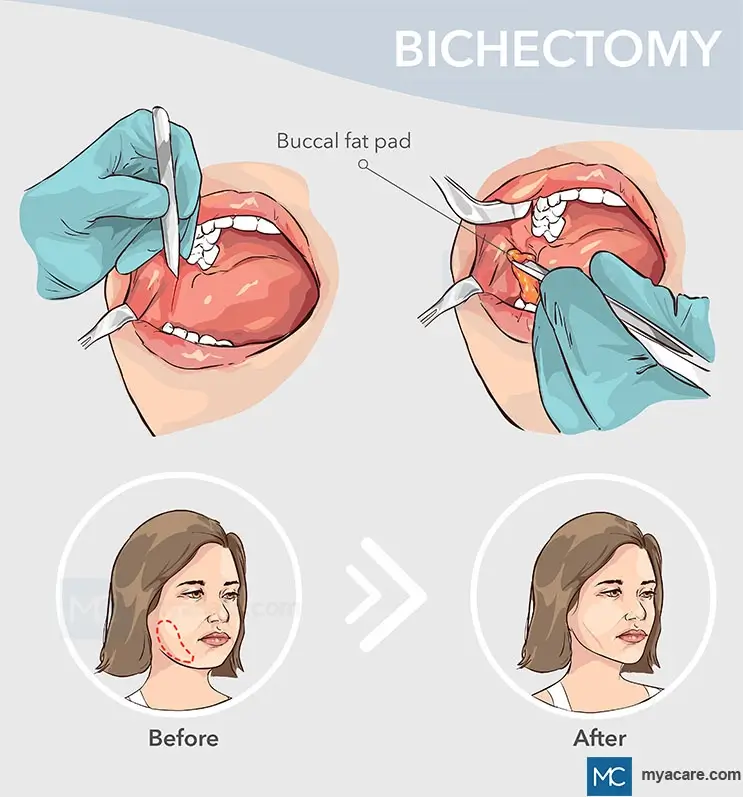Bichectomy – The “Hollywood Cheek” Procedure

If I had to name a single plastic surgery procedure that's benefited the most from the so-called selfie culture, I'd choose bichectomy. The buccal fat removal technique owes its growing popularity to social networks, influencers, and celebrities. No wonder it has such a glamorous nickname - The Hollywood Cheek!
The pursuit of perfection in Instagram posts popularizes chiseled facial contours. Prominent cheekbones and a well-defined jawline are wanted the most, and if filters cannot give them to you, plastic surgery can.
However, much like all other invasive procedures, bichectomy carries a risk of complications. Also, not everyone is a good candidate. But, if you wish to learn all about it, keep reading the article below.
Overview
Buccal fat removal is a cheek reduction technique. It is most popular among younger people looking to re-contour their face more elegantly and attractively.
The procedure does not last long, and it is not as complicated as some other types of plastic surgery. However, bichectomy is still an invasive surgical procedure that requires the use of a scalpel, sutures, local anesthesia, and a reasonable recovery period.
As such, it needs to be carried out by a board-certified plastic surgeon in a controlled environment. The risks of an unsatisfying aesthetic result and complications are real. We will discuss them all later in the article.
What is bichectomy?
The goal of bichectomy is to make the face thinner by removing buccal fat. Now, if you are wondering what buccal fat is, here comes the answer. Buccal fat is a rounded fat deposit located in the middle of a cheek. It sits just under the cheekbone, in-between the facial muscles.
Everyone has buccal fat, but not the same amount. Some skinny people can have more of it than their bulkier counterparts.
A properly executed bichectomy can re-shape the face and give it a less round appearance.
However, unwarranted buccal fat removal can also produce a negative aesthetic result. Other complications can follow. That's why everyone should approach this procedure with care.
Each person's face has a unique anatomy. Not in terms of different bones, muscles, and other tissues. But, in terms of how it all looks together in one piece. The aesthetic appeal depends on angles, distances between facial features, bone size, distribution of fat, and so on.
Lack of volume is usually not good for the skin. However, in some cases, it can be an improvement. If you are considering buccal fat removal, seek first advice from an experienced plastic surgeon. That is the best guarantee you'll make the right choice.
Under total anesthesia, it is possible to combine bichectomy with other plastic surgery procedures, such as breast augmentation, for example. However, keep in mind that these are all surgical procedures with some risk attached to them. The cost is not insignificant too.
The Procedure
For bichectomy alone, there is no need for total anesthesia. The surgeon will numb the cheek with a lidocaine injection. Then, they will make an incision inside the mouth, where lower and upper teeth meet.
The incision reveals the buccal fat pad, which is then gently taken out. The wound is then cauterized and closed with absorbable sutures. The entire procedure lasts around thirty minutes.

Recovery takes between seven and ten days. In the beginning, patients may experience some swelling, mild pain, and discomfort, especially while chewing. So, a soft food diet is the best choice. Full results become visible after four to six months.
For optimal recovery, ice the cheek area for two days after the procedure. Also, avoid exercise or other demanding physical activity for the next two weeks. Your doctor will probably prescribe an antibiotic therapy to prevent infections. Don't expect to go back to work during the first week after surgery.
Potential Complications
A poorly trained surgeon can cause nerve damage. A blockage of parotid ducts, the tubes that pass saliva from the parotid gland and into the mouth, is a possibility too. However, such complications are rare at the hands of experienced professionals.
As with other similar procedures, infections, blood accumulation (hematoma), and fluid accumulation (seroma) are possible but uncommon.
The unsatisfying aesthetic result is possible. More so, when buccal fat removal is unjustified.
Patients can later struggle with unnecessary loss of volume and premature skin aging. The unattractive, plastic, or bony-looking face can also result from the lack of buccal fat.
Other complications of bichectomy may include:
- Poor wound healing
- Bleeding
- Loss of sensation
- Persistent pain
- Deep vein thrombosis
- Facial asymmetry
- Complications from anesthesia
It is invaluable to mention that cheek fat has a role in facial anatomy and the proper functioning of other tissues. The purpose of fat is to lubricate the muscles responsible for chewing and speaking.
Taking the fat out can cause functional and aesthetic problems. With age, a person can develop a skeletal, sunken cheeks look. Luckily, this is fixable. Dermal filler injections can rectify the issue to a certain extent.
Who's a good candidate?
Anyone can get buccal fat removed from their cheeks, but that's not always a good idea.
If your face is already thin and narrow, a bichectomy will not make your cheekbones stand out. However, dermal fillers will. So, you can save money and get a better aesthetic effect with a minimally invasive procedure rather than surgery.
On the other hand, skinny individuals with chubby cheeks are the best candidates. Slightly overweight patients can benefit too. In such cases, combination treatment with neck liposuction can emphasize the final result.
The Bottom Line
Whether or not you get a bichectomy is your decision. But, before you make it, consult an experienced plastic surgeon. It's a thin line between a subtle but satisfying improvement and an aesthetic disaster with potential complications. Remember, this is cosmetic surgery, not a basic need. However, if you do things right, you'll end up with the best natural-looking version of yourself.
To search for the best Plastic & Cosmetic Surgery healthcare providers in Croatia, Germany, Greece, India, Malaysia, Singapore, Slovakia, Spain, Thailand, Turkey, Ukraine, the UAE, the UK and the USA, please use the Mya Care search engine.

Dr. Rosmy Barrios is an aesthetic medicine specialist with international work experience. She earned her physician diploma at the Universidad Del Norte’s School of Medicine in Barranquilla, Colombia, and her specialty at John F. Kennedy University in Buenos Aires, Argentina. Dr. Barrios is a member of the Pan-American Aesthetic Medicine Association (PASAM) and the Union Internationale de Médecine Esthétique (UIME). She is an expert health writer with keen interests in aesthetic medicine, regenerative aesthetics, anti-aging, fitness, and nutrition. Currently, Dr. Barrios heads the Regenerative Aesthetics department at a renowned Internal Medicine clinic based in Belgrade, Serbia.
References:
Featured Blogs



